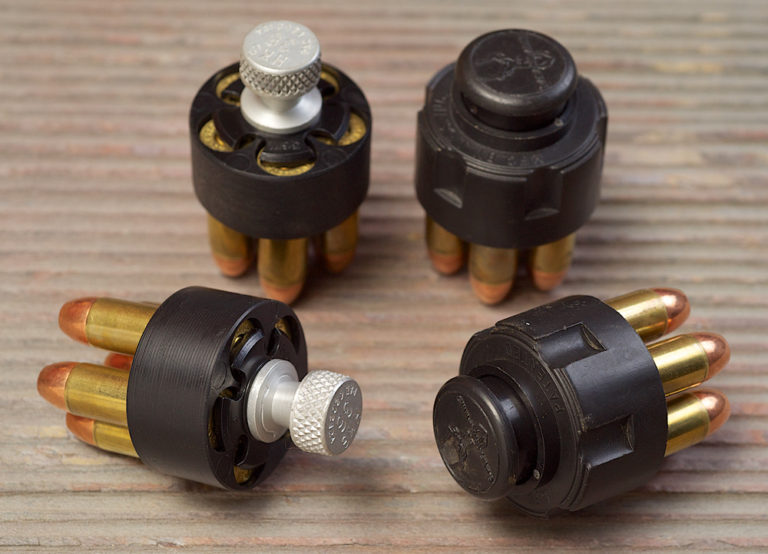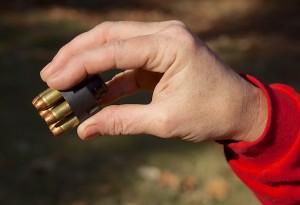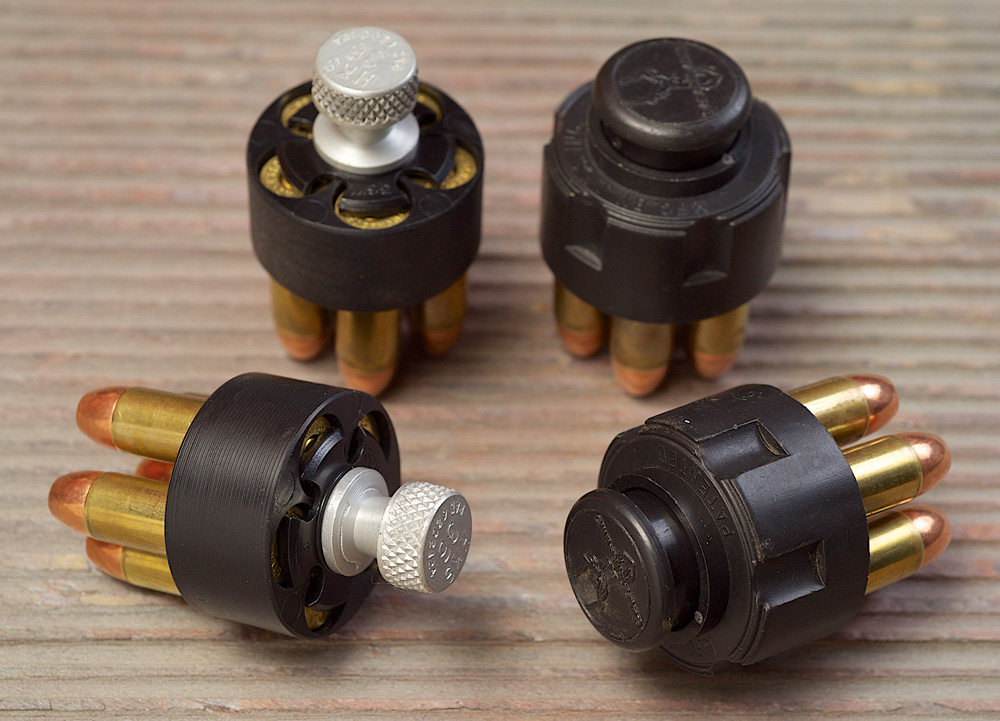
The most efficient way to recharge your revolver is to use a speedloader. The speedloader inserts all rounds into the cylinder simultaneously and greatly reduces the fiddling necessary to get bullet noses started into their chambers.
Speedloader Technique
The speedloader really comes into its own when paired with the Universal Revolver Reload. With one hand holding the cylinder and the other handling the speedloader you can take advantage of proprioception; all you need to do is to bring your hands together and the speedloader will be right on top of the cylinder where it needs to be.

Reloading in the dark or while keeping your eyes on your threat is more efficiently accomplished with the speedloader than with any other method.
Like anything else, there is a technique to using the speedloader. Poor speedloader technique can slow the reload significantly. Here’s what I’ve found to be the best way to use one.
When you retrieve your speedloader, it’s important to grasp it by the body, and ideally so that your fingers align with and extend just past the bullet noses. This slightly enhances the effect of proprioception and makes it easier to handle the speedloader. If you don’t get it exactly right, don’t worry; the technique won’t fail if your fingers aren’t in exactly the right place. The most important thing is to grasp the speedloader by the body, not by the knob!
As you bring the hand with the speedloader toward the one that is holding the cylinder, proprioception ensures that the speedloader will naturally end up over the chambers. Just bring your hands together.
(Some trainers advise, and I used to teach, that the tips of your fingers can make contact with the edge of the cylinder to help align the rounds with the chambers. I’ve found that’s not necessarily true, particularly if your initial grasp of the speedloader doesn’t leave your fingertips in front of the bullet noses. Instead, I now teach to simply bring your hands together – the speedloader will be in just the right position automatically.)
Sometimes you’ll get lucky and the bullet noses happen to line up with the chambers; other times they’ll line up on the metal between the chambers. The solution is simple: as the bullet noses come into contact with the cylinder, simply jiggle the speedloader by twisting it very slightly and very quickly clockwise and counter-clockwise. The bullets will drop into the chambers without further work on your part. (This is a fine motor skill, which validates my insistence on using your most dexterous hand to do the job.)
After the rounds have dropped into the chambers, release them by whatever method your speedloader brand requires. If you’re using a Safariland or SL Variant, simply push the body of the speedloader toward the cylinder and the rounds will release.
If your speedloader is an HKS or similar design, insert the rounds into the cylinder, then grab the knob and twist it to release the rounds.
As the rounds drop from the speedloader, pull it straight back out to make sure all of the rounds have cleared, then drop it over the side of the gun. This eliminates another failure point of the reload procedure: rounds binding in the loader.
It’s not uncommon to have the speedloader tilt just a bit and cause a round or two to bind inside the loader. When this happens the round(s) don’t clear the loader, and if you attempt to close the cylinder you’ll trap that round(s) and the speedloader against the frame of the gun. You’ll then need to open the cylinder, grab the speedloader, shake the round(s) loose and finally finish the reload. Yes, it’s time consuming and aggravating, which is why I strive to avoid it by lifting the loader and allowing the rounds to drop free, then tossing the speedloader away.
Speedloader Recommendations
The two most common and widely available speedloaders on the market are the Safariland, which use a push-to-release mechanism, and the HKS, which releases by turning a knob. (There are other examples of each style, such as the push-type SL Variant and the turn-type Five Star, but Safariland and HKS are by far the most readily available. They’re the least expensive in their respective categories as well.)
In general I much prefer the Safariland, simply because they’re more intuitive in use. You’re already grasping the speedloader by its body and pushing the rounds into the cylinder; releasing the rounds from the Safariland is a simple continuation of that movement. The HKS style, on the other hand, requires you to release your grasp of the body, find the knob and grab it, then twist it in the proper direction to allow the rounds to drop into the cylinder. I don’t consider that as intuitive as simply continuing pushing the way you’re already pushing.
I’ve also found that the Safariland speedloaders, when properly loaded, are more secure. They’re less likely to accidentally release in a pocket or when dropped.
This article is an excerpt from the new book Defensive Revolver Fundamentals by Grant Cunningham. Click here to get your copy.

Next Step: Get your FREE Printable Target Pack
Enhance your shooting precision with our 62 MOA Targets, perfect for rifles and handguns. Crafted in collaboration with Storm Tactical for accuracy and versatility.
Subscribe to the Gun Digest email newsletter and get your downloadable target pack sent straight to your inbox. Stay updated with the latest firearms info in the industry.


![Best Concealed Carry Guns In 2025 [Field Tested] Wilson Combat EDC X9S 1](https://gundigest.com/wp-content/uploads/Wilson-Combat-EDC-X9S-1-324x160.jpg)


![Best 9mm Carbine: Affordable PCCs [Tested] Ruger Carbine Shooting](https://gundigest.com/wp-content/uploads/Ruger-Carbine-Shooting-100x70.jpg)
![Best AR-15: Top Options Available Today [Field Tested] Harrington and Richardson PSA XM177E2 feature](https://gundigest.com/wp-content/uploads/Harrington-and-Richardson-PSA-XM177E2-feature-100x70.jpg)
